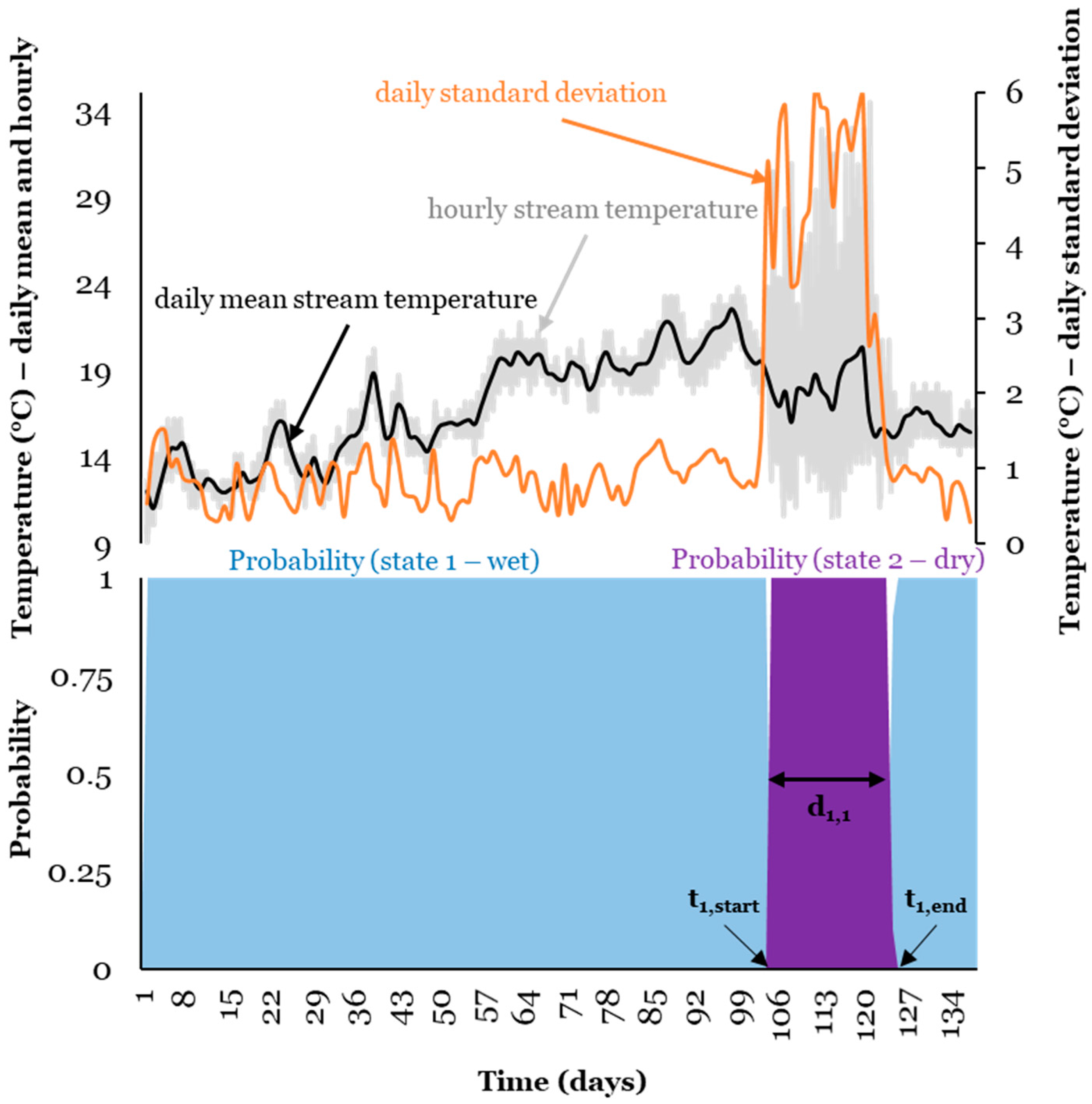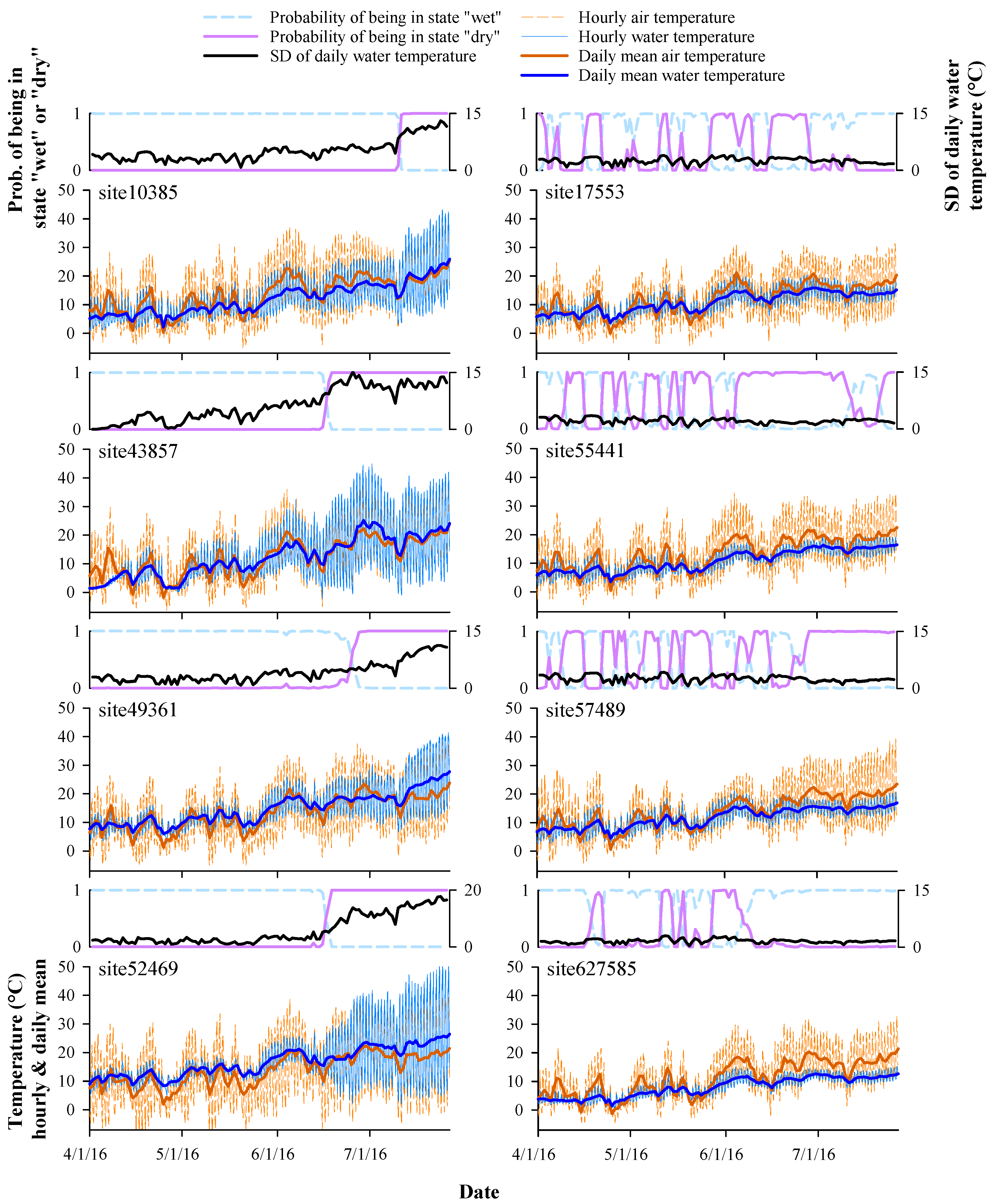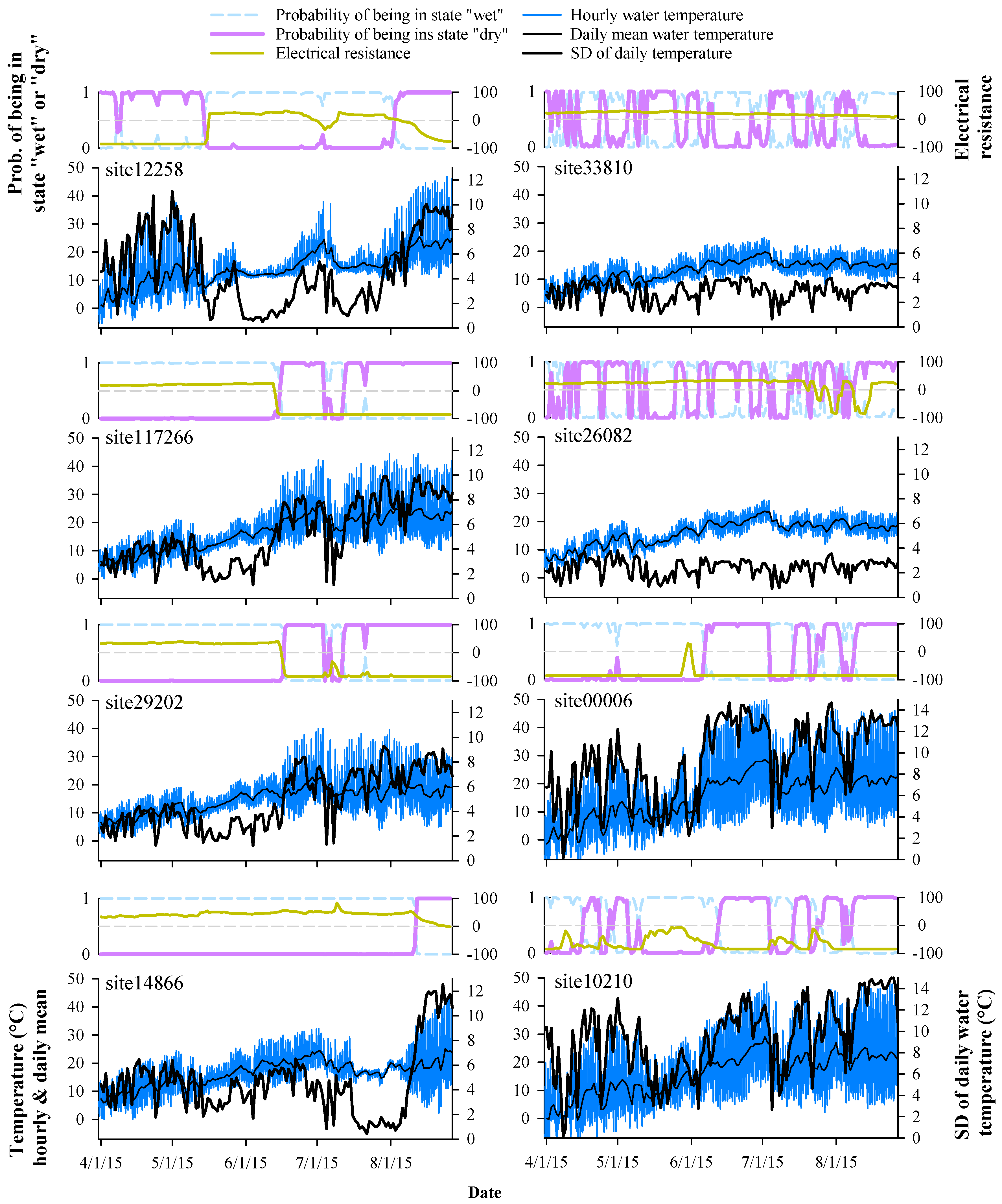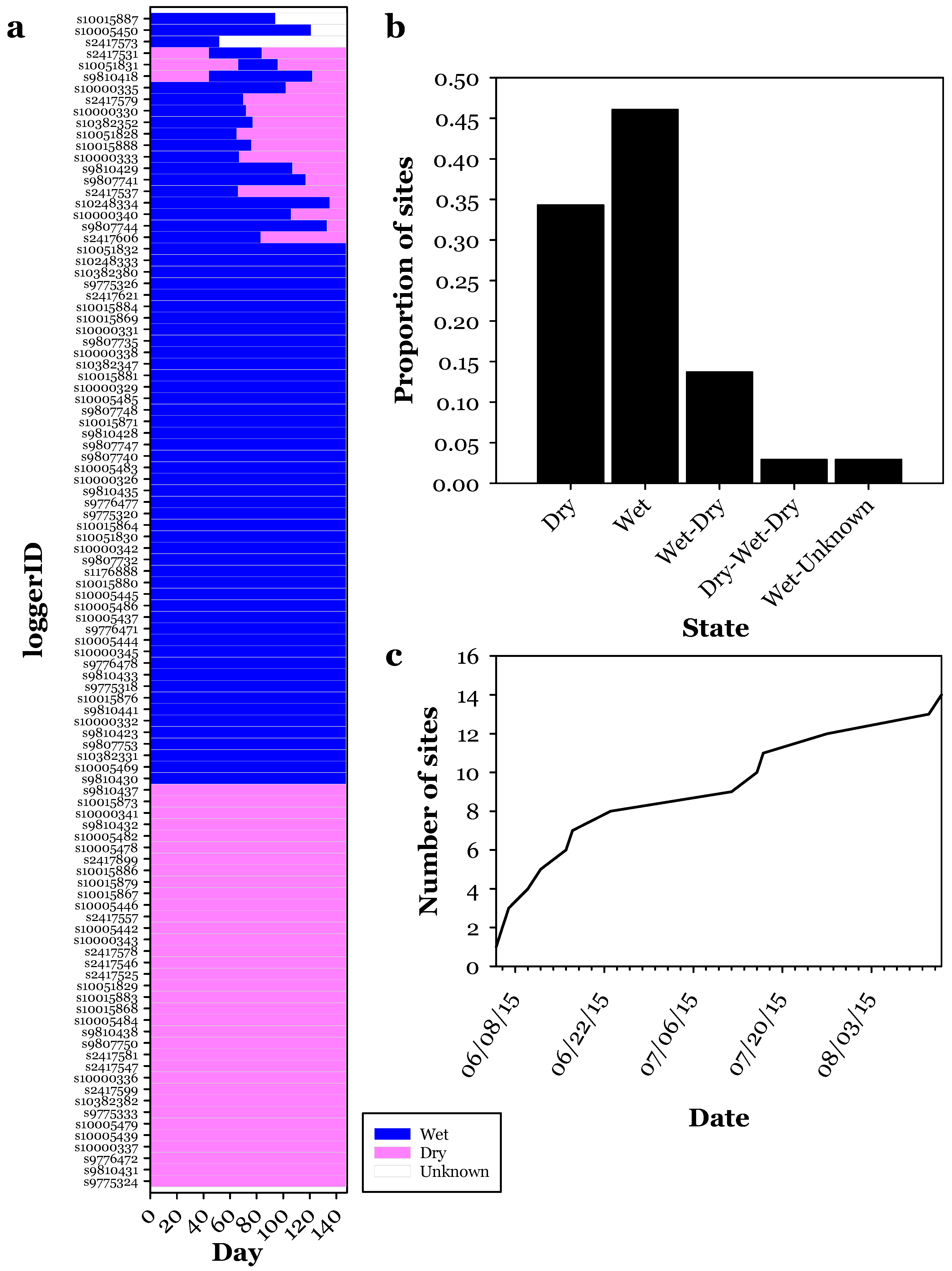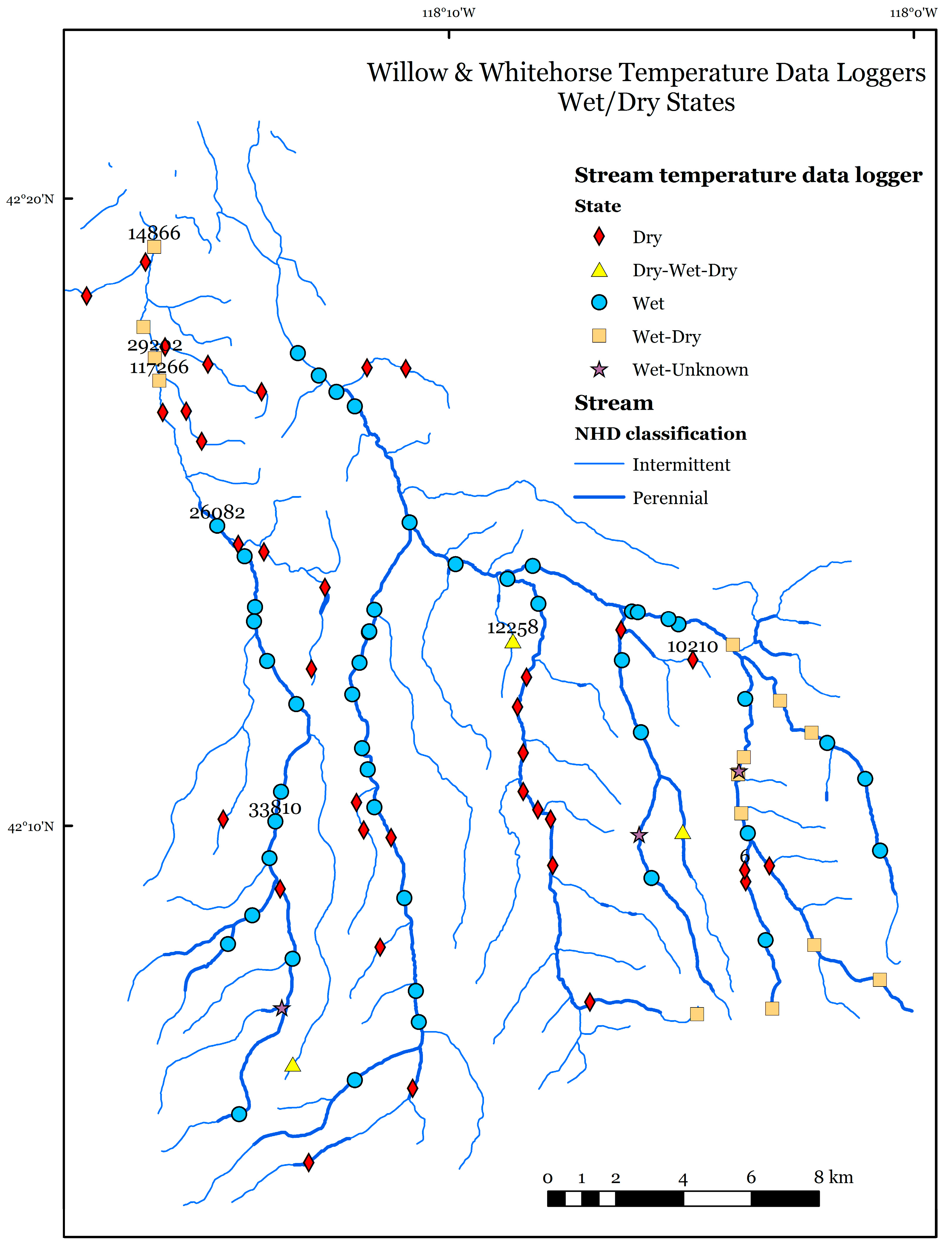1. Introduction
Perhaps one of the most fundamental issues concerning flow permanence in stream channels is the lack of understanding about expected spatial and temporal patterns across landscapes, riverscapes, or stream networks [
1,
2]. Many studies, ranging from work conducted in the 1950s [
3] to more contemporary assessments [
4,
5], consistently point to inaccuracies in characterization of flow permanence on existing maps. Efforts to improve quantification of flow permanence in the field have involved a host of techniques ranging from direct observation to various forms of instrumentation [
6,
7]. Among these, indirect quantification of flow permanence via time series of temperature recorded in stream channels is particularly promising. These instrumental records are already available in many regions, often comprising datasets consisting of thousands of individually monitored sites [
8]. In practice, stream temperature records that indicate a dry stream channel are often edited or deleted, without considering the value of such information in diagnosing drying.
As a first step to diagnosing drying, Sowder and Steel [
9] recommend several automatable checks that allow users to flag potentially aberrant time periods from these time series, followed by visual inspection of the flagged temperature records. Because the specific heat of water is over four times that of air, data loggers in dry stream channels typically display highly variable daily temperature records [
10,
11]. Secondly, Sowder and Steel [
9] recommend examining paired water and air temperature records for a given site, if available.
In this study, we build on prior work to apply a more formal statistical method, Hidden Markov Models (HMMs) [
12], to diagnose patterns of stream drying from hourly records of stream temperatures. We first applied HMMs to a selection of sites with paired air and in-channel temperature recordings to compare daily variability in each [
9,
10] and illustrate how HMMs can allow for more objective identification of transitions between wet and dry states in stream channels. Next, we used information from pairs of in-channel temperature data loggers and electrical resistors that instantaneously detect loss (or gain) of flows [
13]. This allowed us to compare results of statistical analyses with known measurements of flow permanence at selected sites. Finally, we applied HMMs across a full network of locations monitored within a large watershed [
14] to illustrate patterns in the timing, duration, and frequency of flow permanence in the system [
1]. Collectively, these results illustrate a new and readily applied method that can be used to rigorously quantify stream flow permanence regimes from existing records of stream temperature. This may be relevant to assess responses of flow permanence to a host of potential influences, including changing climatic conditions and the effects of land and water uses [
1,
5].
3. Results
HMMs applied to time series of daily SD of stream temperatures successfully identified and separated signals from wet and dry conditions of stream reaches when paired stream and air temperature data loggers were examined at WRC during the period 1 April–27 July 2016 (
Figure 3). The use of HMMs allowed us to identify what visually appeared to be both dry and wet states as well as their shifts over time. At WRC, we found patterns of wet–dry (e.g., site10385, site43857, site49361 and site52469), and purely wet states (e.g., site17553, site55441, site57489 and site627585). The use of HMMs was also effective in identifying shifts in timing between dry and wet states when sites went dry at different times (e.g., site10385 versus site43857 and site52469). The timing and type of state identified by each HMM closely tracked visual convergence of daily SD in stream channels and air temperatures as channels dried. In cases when the HMM identified a single wet state, contrasting hourly time series of stream and air temperature (i.e., site17553, site55441, site57489 and site627585) also provided visual corroboration.
Pairing of electrical resistors and stream temperature data loggers in WWC provided confirmation of drying in the field and opportunities to evaluate how HMMs diagnosed drying based on daily SD of stream temperatures (
Figure 4). The timing of drying, if a site experienced drying, was indicated by negative values recorded by the electrical resistors (positive values represented wet conditions). Time series of daily SD of stream temperature used as inputs for HMMs extended from 1 April to 27 August 2015. Among the eight sites with paired electrical resistors, we identified four patterns of change, including dry–wet–dry (e.g., site12258), wet–dry (e.g., site117266, site29202, and site14866), continuously wet (e.g., site33810, site26082) and continuously dry (e.g., site00006, site10210). The use of HMMs was effective in diagnosing all of these cases, regardless of the timing of shifts between states or degree of synchrony (timing of changes in states) among them (e.g., site117266 and site29202 versus site14866). In cases when the HMM identified a single state (dry or wet) occurring during the entire time period, we used a second source of information (hourly stream temperature) to visually confirm and separate between a single wet (site33810, site26082) and a single dry state (site00006, site10210).
To examine spatial patterns of stream drying, we applied HMMs to 102 time series of daily SD of stream temperature at the WWC (
Figure 5 and
Figure 6). Our approach allowed us to identify both single and multiple states occurring among stream reaches during the period 1 April–27 August 2015. The majority of sites (80%) within WWC exhibited a single state with most of them (46%) having water over the entire time. There were also sites that showed one or more shifts among states (17%) with most of them shifting from wet to dry (14%). The cumulative number of sites that changed from wet to dry was useful to identify patterns of drying over time (
Figure 5). There were two time periods that illustrated a rapid (5 June to 22 June 2015) versus a slow (23 June to 13 August 2015) pattern of drying (
Figure 5c). The timing, duration and frequency of events (wet or dry) can also be extracted from this analysis as well as the spatial coherence among nearby sites. To provide a simple illustration, we mapped the presence of permanent wet or dry sites, as well as those that changed in state within the study time frame (1 April to 27 August 2015,
Figure 6).
4. Discussion
Our findings demonstrate that Hidden Markov Models (HMMs) can effectively diagnose drying of stream channels based on patterns of variability in hourly recorded stream temperatures, without a need for data loggers specifically designed to detect drying [
20]. Specifically, increases in the daily SD associated with the transition from water to air as streams dried produced a strong and predictable signal that was relatively easy to detect [
10]. Though most methods to detect drying from temperature records are based on qualitative screens [
9], application of Hidden Markov Models removes much, but not all, of the subjectivity that can be a limitation of such approaches.
Because we were interested in only two states in stream channels—wet or dry—we applied a two-state HMM to each sampled location. In cases where the true state was likely continuously dry or wet, the hidden Markov model produced unrealistically high frequency changes in states (e.g., seven or more within the time span we analyzed). Thus, as applied here, our choice of states and the decision to assign one or two states to any given site still involved an element of subjectivity, but less so than the level of subjectivity involved with existing methods of diagnosing drying [
9]. Note here that we refer to drying at the point where our field data loggers were no longer in water. We deployed our instruments in the stream channel thalweg, therefore we are confident that if an instrument was no longer in water that the stream indeed dried at the sampled location, but we cannot extrapolate beyond that point (e.g., to intermittent reaches outside of the site or any conditions outside of the data logger itself).
As a general procedure to diagnose drying based on our findings, we recommend the following series of steps. To begin, we recommend initially plotting individual time series of stream temperature to visually identify potential anomalies. If available, information from nearby air temperature time series can be compared to stream temperatures to look for evidence of drying [
9]. Following these steps, we recommend separating the time series into potential wet and dry seasons. In this study, we considered the dry season to be the time frame over which drying of streams was most likely (i.e., from 1 April into late summer). With this period of inference defined, an HMM can be applied to evaluate evidence for changes in state based on daily SD of temperature. If the HMM procedure results in an unexpectedly large number of changes among states (approximately seven in our study region) that do not relate to likely drivers of stream flow permanence (e.g., episodic patterns of water diversion, snowmelt, or precipitation), then there is likely only one true single state (wet or dry). To identify if the true single state represents wet or dry conditions, we recommend using air temperature time series from nearby sites as reference information. In our study region, for example, we reasoned that if maximum daily stream temperature was the same as maximum daily air temperature and both were above 30 °C, then the true state was likely dry. To further clarify whether a state represents the wet or dry condition of the site, we also used field notes describing the condition of data loggers during deployment and retrieval and available time series of air temperature. Finally, the assignment of states can be defined based on the table of probabilities (e.g., >0.5 for a given state) from the HMM output. Thus, we do not recommend diagnosing drying based on applications of HMMs alone, but rather as a complement to existing methods for screening temperature data [
9,
10].
Statistical issues aside, it is worth noting that the relatively arid systems we studied present a stark contrast between hydrologic (wet) and atmospheric (dry) conditions influencing heat fluxes, and thus the signal within the daily SD of temperatures. In very humid systems, or during times of the year when clouds, short photoperiods, snow cover, or other confounding factors could be in play, the thermal signature of water versus air may be less pronounced, and statistical pattern detection to diagnose drying may be less efficient. In such cases, the only alternative may be to deploy a more diverse data logger array [
20] or alternative models for pattern detection in highly ephemeral systems [
21]. It is also important to emphasize that we considered only a portion of the year (spring–summer) in this study. Studies of year-round variability in temperature [
22] may encounter other changes in state, such as freezing in winter. Additional tests of the efficiency of HMMs for diagnosing drying under a broader range of conditions (continuous information on temperature with known patterns of drying) would be needed to more comprehensively evaluate where and when they are most likely to be useful. Given widespread and increasing amounts of stream temperature data collected from continuously recording temperature data loggers, information on flow permanence extracted from time series of temperatures using Hidden Markov Models offers potentially powerful new insights into patterns of flow permanence.
Although the question of flow permanence has drawn increasing attention in scientific and policy arenas [
23], the fundamental problem of quantifying the status of flowing water in stream networks represents a long-standing challenge. Flow permanence in streams can be classified based on the processes that generate flows [
24] and the corresponding timing, duration, and extent of flows at any given location [
1]. Past stream flow permanence classifications have proven quite useful, but they may not be detailed enough to capture hydrologically and ecologically important dynamics in the timing, duration, frequency, and extent of flow events in stream networks [
1] that are possible to extract from time series of temperature, as we have demonstrated here. Our application of HMMs across an entire stream network demonstrates the utility of this approach to describe patterns in the timing, duration, and frequency of flow permanence within a large watershed. Specifically, our findings show that most of the sites that were sampled within the stream network stay wet or dry during the entire season. In addition, some stream reaches synchronously shift from a wet to a dry state, but some sites shift sooner than others. In our study system, a detailed understanding of patterns of flow permanence was critical for identifying potential ecological responses of both aquatic and terrestrial species to seasonally and annually shifting patterns of water availability across the landscape [
14]. Furthermore, our proposed method, in combination with modeling of flow duration curves (e.g., [
25,
26,
27]), may be useful to understand shifts between wet and dry conditions or to determine minimum streamflow requirements in non-perennial (intermittent or ephemeral) streams.
In the context of possible drying of stream channels due to warming climates and increased probability of drought [
14,
28], understanding patterns of flow permanence in streams is paramount. Existing efforts to crowd-source stream temperature datasets across the northwest U.S., for example, have proven immensely valuable for predicting stream temperature across drainage networks and evaluating climate vulnerability for coldwater species [
8]. However, these datasets are often biased towards perennial streams, as data from dry streams are typically removed [
9]. The approach described herein highlights the value of such observations to contribute critical information on climate-sensitive patterns of flow permanence [
1,
5]. These, in turn, can be incorporated with information on thermal regimes from perennial streams to provide a more dynamic and comprehensive view of water quality and availability across broad spatial extents.

